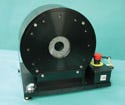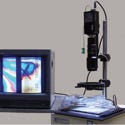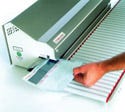Passing the Test
January 16, 2005
Originally Published MPMN January 2005
PRODUCT UPDATE
Passing the Test
Inspection and monitoring processes improve with new technology and expanded services
Corinne Litchfield
|
Radial expansion force equipment from Machine Solutions Inc. measures a stent’s hoop force using segmental compression. |
During the product development process, medical device manufacturers must conduct testing in order to evaluate safety and performance. Monitoring exposure to gases used in the medical device industry, such as during sterilization and validation procedures, may also be necessary. This article discusses the latest news from testing facilities, as well as machinery and products available for package and product testing.
Expansion of Testing Services Builds on Existing Relationships with Customers
An increase in customer requests and the company’s knowledge of the testing industry drove the decision by DDL (Eden Prairie, MN) to recently expand its product test engineering team as well as its testing facilities. “We can now not only test the package, but the product inside as well,” says CEO John Hart.
Already known for its package-testing services, the company is building on its reputation with existing customers. “We expect this to be a significant new area of business,” says Hart.
Established in 1990 as a package- testing company, DDL quickly grew to include materials testing of polymers, elastomerics, and synthetics. Over the past year, the company saw more requests for testing of catheters, implantables, and other medical devices, making the expansion into product- testing capabilities a logical step forward.
While product-testing services will initially be available only through its Eden Prairie location, the company plans to expand such services to its California facility.
Stent-Testing Equipment Eliminates Test Variability
Hoop force is the outward force originating at the center of a tube and is equal in all directions. In the case of balloon-expandable stents, it is the force that the stent exerts on a blood vessel. For self-expanding stents, it is the force that the stent applies while it expands. FDA requires hoop force testing prior to product approval, yet there is no established standard for testing. Some commonly used methods include a tape method that incorporates radial compression and friction, flat plates that bend the stent at two points, and v-blocks that bend the stent at four different locations. None of these methods is ideal. Both the flat plate and v-block methods do not test radial compression, an important factor in evaluating stent hoop force, and the tape method uses a piece of fabric that is subject to environmental variables.
|
The video polarimeter system from Strainoptics Inc. inspects stress and strain patterns in |
However, a new device might solve these problems. Machine Solutions Inc. (Flagstaff, AZ) aims to make its RX500 radial expansion force gauge the new industry standard. The RX500 uses a 12-point segmental compression system. It is controlled by a microstepping linear actuator designed to provide a low-friction testing environment. With reduced friction levels, the equipment eliminates the test variability and measures product variability. “The RX500 provides much more accurate and repeatable test results,” says Melissa Lachowitzer, product testing division manager.
All electronics and workings are separate from the machine’s testing head, which can be removed for heating or cooling. The calibration process is simple and the equipment requires little maintenance.
Machine Solutions also offers torque-testing equipment and contract testing services. In keeping with its goal of automating or semiautomating processes in catheter and stent manufacturing, the company plans to launch stent-dislodgement equipment in the future.
Package Seal Testing Delivers the Goods
Preserving the sterility and integrity of packaged biomedical products is necessary, yet many testing methods can damage the packaging, seal, or contents. A new line of noninvasive oxygen measurement systems from OxySense Inc. (Dallas) allows manufacturers to assess oxygen levels within containers, bottles, and packages without puncturing or destroying the seal. The OxySense 4000 is fully portable and self-contained, with an integrated 8.4-in. display, built-in processor, and automatic infrared temperature sensor. The 200T model attaches directly to a laptop or PC. Applications include oxygen permeation studies for packaging of sterilized medical devices and anaerobic testing in sealed containers.
Hawo GmbH (Obrigheim, Germany) offers Seal Check test strips for evaluating packaging seals. Designed for daily testing of the company’s continuous sealer machines, the products use an indicator strip to show whether there are punctures or tears, material delamination or separation, channels, or open seals. Any deviations in the machine’s sealing temperature or pressure are visible on the strip. When used on a daily basis, Seal Check strips can ensure that the sealing device is working correctly and at optimum efficiency. If the sealer machine has an integrated Seal Check function, the critical sealing parameters, test date, and tester name can be simultaneously printed on the reverse side of the test strip by an electronic printer.
Stress Patterns, Mechanical Properties Are Among Tests Conducted on Plastic Products
Materials testing of plastics and elastomers measures everything from strength to elasticity. The video polarimeter system from Strainoptics Inc. (North Wales, PA) enables rapid inspection of strain patterns in clear and translucent plastic products. The system consists of a high-precision, laboratory-quality polarimeter equipped with a color CCD video camera with 6–32¥ zoom magnification and a high-resolution color CCTV monitor. Unacceptable gradients of stress or strain are detected by measuring double refraction in the plastic being tested.
|
Hawo GmbH offers Seal Check test strips to monitor seal quality in the company’s continuous seal machines. |
For the engineer needing to test mechanical and melt properties of various plastics, ATS Rheosystems (Bordentown, NJ) offers the Dynalyser rheometer. Designed for testing materials such as thermoplastics, thermosets, elastomers, semisolids, and fluid systems, the Dynalyser performs steady shear, transient, and dynamic oscillatory measurements using parallel plate, cone and plate, couette, rectangular torsion, dynamic tension, and other fixtures. The rheometer's true 32-bit, multitasking software is Windows-based and provides a convenient platform for instrument operation, data analysis, and system networking. The unit uses an environmental control system with an indirect heated and cooled oven that is equipped to test polymer melts, solids, and fluid materials. The oven’s heating element incorporates a circulation air flow for temperatures ranging from –180° to 550°C.
EtO Monitors Allow for Safer Sterilization Facilities
Prolonged exposure to ethylene oxide (EtO) used in sterilization processes can be hazardous to employee health. Two new products have been designed to detect and monitor EtO levels.
The EtO monitor from Assay Technology (Pleasanton, CA) can be used to document compliance with OSHA regulations. The monitor can be placed in an employee breathing zone to document exposure for either 8 hours or 15 minutes, then it is returned to the company’s laboratory, where a report of exposure levels is available within 6 working days.
EtO gas detectors from Kernco Instruments Company Inc. (El Paso, TX) feature adjustable set points and alarms. Designed for continuous monitoring of EtO levels, the sensor elements in the detectors are explosion-proof and rated for Class I Division I, Group A-B-C-D hazardous atmospheres. Readout ranges are given in either 0–10 or 0–100 ppm, and both visual and audible alarms are activated when the level has been exceeded.
Copyright ©2005 Medical Product Manufacturing News
You May Also Like




.png?width=300&auto=webp&quality=80&disable=upscale)
